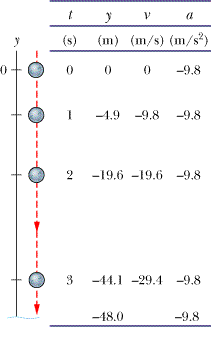| 2-9 Free-Fall Acceleration | ||
Penny and Feather |
Large Double Ball Drop |
If you tossed an object either up or down and could somehow eliminate the effects of air on its flight, you would find that the object accelerates downward at a certain constant rate. That rate is called the free-fall acceleration, and its magnitude is represented by g. The acceleration is independent of the object's characteristics, such as mass, density, or shape; it is the same for all objects.
Two examples of free-fall acceleration are shown in Figure 2-9, which is a series of stroboscopic photos of a feather and an apple. As these objects fall, they accelerate downward—both at the same rate g. Thus, their speeds increase at the same rate, and they fall together.
 |
| Fig. 2-9 A feather and an apple free fall in vacuum at the same magnitude of acceleration g. The acceleration increases the distance between successive images. In the absence of air, the feather and apple fall together. |
Freefall |
The value of g varies slightly with latitude and with elevation. At sea level in Earth's midlatitudes the value is 9.8 m/s2 (or 32 ft/s2), which is what you should use as an exact number for the problems in this book unless otherwise noted.
The equations of motion in Table 2-1 for constant acceleration also apply to free fall near Earth's surface; that is, they apply to an object in vertical flight, either up or down, when the effects of the air can be neglected. However, note that for free fall: (1) The directions of motion are now along a vertical y axis instead of the x axis, with the positive direction of y upward. (This is important for later chapters when combined horizontal and vertical motions are examined.) (2) The free-fall acceleration is negative—that is, downward on the y axis, toward Earth's center—and so it has the value -g in the equations.
|
The free-fall acceleration near Earth's surface is a = -g = -9.8 m/s2, and the magnitude of the acceleration is g = 9.8 m/s2. Do not substitute -9.8 m/s2 for g. |
Suppose you toss a tomato directly upward with an initial (positive) velocity v0 and then catch it when it returns to the release level. During its free-fall flight (from just after its release to just before it is caught), the equations of Table 2-1 apply to its motion. The acceleration is always a = -g = -9.8 m/s2, negative and thus downward. The velocity, however, changes, as indicated by Equation 2-11 and Equation 2-16: during the ascent, the magnitude of the positive velocity decreases, until it momentarily becomes zero. Because the tomato has then stopped, it is at its maximum height. During the descent, the magnitude of the (now negative) velocity increases.
|
On September 26, 1993, Dave Munday went over the Canadian edge of Niagara Falls in a steel ball equipped with an air hole and then fell 48 m to the water (and rocks). Assume his initial velocity was zero, and neglect the effect of the air on the ball during the fall.
(a) How long did Munday fall to reach the water surface?
Solution: The Key Idea here is that, because Munday's fall was a free fall, the equations of Table 2-1 apply. Let us place a y axis along the path of his fall, with y = 0 at his starting point and the positive direction up the axis (Figure 2-10). Then the acceleration is a = -g along that axis, and the water level is at y = -48 m (negative because it is below y = 0). Let the fall begin at time t = 0, with initial velocity v0 = 0.
 |
| Fig. 2-10 The position, velocity, and acceleration of a freely falling object, here the steel ball ridden by Dave Munday over Niagara Falls. |
From Table 2-1 we choose Equation 2-15 (but in y notation) because it contains the requested time t and all the other variables have known values. We find
 |
and
 | (Answer) |
Note that Munday's displacement y - y0 is a negative quantity—Munday fell down, in the negative direction of the y axis (he did not fall up!). Also note that 48/4.9 has two square roots: 3.1 and -3.1. Here we choose the positive root because Munday obviously reaches the water surface after he begins to fall at t = 0.
(b) Munday could count off the three seconds of free fall but could not see how far he had fallen with each count. Determine his position at each full second.
Solution: We again use Equation 2-15 but now we substitute, in turn, the values t = 1.0 s, 2.0 s, and 3.0 s, and solve for Munday's position y. The results are shown in Figure 2-10.
(c) What was Munday's velocity as he reached the water surface?
Solution: To find the velocity from the original data without using the time of fall from (a), we rewrite Equation 2-16 in y notation and then substitute known data:
 |
so
 | (Answer) |
We chose the negative root here because the velocity was in the negative direction.
(d) What was Munday's velocity at each count of one full second? Was he aware of his increasing speed?
Solution: To find the velocities from the original data without using the positions from (b), we let a = -g in Equation 2-11 and then substitute, in turn, the values t = 1.0 s, 2.0 s, and 3.0 s. Here is an example:
 | (Answer) |
The other results are shown in Figure 2-10.
Once he was in free fall, Munday was unaware of the increasing speed because the acceleration during the fall was always -9.8 m/s2, as noted in the last column of Figure 2-10. He was, of course, sharply aware of hitting the water because then the acceleration abruptly changed. (Munday survived the fall but then faced stiff legal fines for his daredevil action.)
|
In Figure 2-11, a pitcher tosses a baseball up along a y axis, with an initial speed of 12 m/s.
 |
| Fig. 2-11 A pitcher tosses a baseball straight up into the air. The equations of free fall apply for rising as well as for falling objects, provided any effects from the air can be neglected. |
(a) How long does the ball take to reach its maximum height?
Solution: One Key Idea here is that once the ball leaves the pitcher and before it returns to his hand, its acceleration is the free-fall acceleration a = -g. Because this is constant, Table 2-1 applies to the motion. A second Key Idea is that the velocity v at the maximum height must be 0. So, knowing v, a, and the initial velocity v0 = 12 m/s, and seeking t, we solve Equation 2-11, which contains those four variables. This yields
 | (Answer) |
(b) What is the ball's maximum height above its release point?
Solution: We can take the ball's release point to be y0 = 0. We can then write Equation 2-16 in y notation, set y - y0 = y and v = 0 (at the maximum height), and solve for y. We get
 | (Answer) |
(c) How long does the ball take to reach a point 5.0 m above its release point?
Solution: We know v0, a = -g, and displacement y - y0 = 5.0 m, and we want t, so we choose Equation 2-15. Rewriting it for y and setting y0 = 0 give us
 |
or
 |
If we temporarily omit the units (having noted that they are consistent), we can rewrite this as
 |
Solving this quadratic equation for t yields
 | (Answer) |
There are two such times! This is not really surprising because the ball passes twice through y = 5.0 m, once on the way up and once on the way down.
| CHECKPOINT 6 (a) In this sample problem, what is the sign of the ball's displacement for the ascent, from the release point to the highest point? (b) What is it for the descent, from the highest point back to the release point? (c) What is the ball's acceleration at its highest point? | ||
| PROBLEM-SOLVING TACTICS |
TACTIC 7: Meanings of Minus Signs
In Sample Problems 2-6 and 2-7, we established a vertical axis (the y axis) and we chose—quite arbitrarily—its upward direction to be positive. We then chose the origin of the y axis (that is, the y = 0 position) to suit the problem. In Sample Problem 2-6, the origin was at the top of the falls, and in Sample Problem 2-7 it was at the pitcher's hand. A negative value of y then means that the body is below the chosen origin. A negative velocity means that the body is moving in the negative direction of the y axis—that is, downward. This is true no matter where the body is located.We take the acceleration to be negative (-9.8 m/s2) in all problems dealing with falling bodies. A negative acceleration means that, as time goes on, the velocity of the body becomes either less positive or more negative. This is true no matter where the body is located and no matter how fast or in what direction it is moving. In Sample Problem 2-7, the acceleration of the ball is negative (downward) throughout its flight, whether the ball is rising or falling.
TACTIC 8: Unexpected Answers
Mathematics often generates answers that you might not have thought of as possibilities, as in Sample Problem 2-7c. If you get more answers than you expect, do not automatically discard the ones that do not seem to fit. Examine them carefully for physical meaning. If time is your variable, even a negative value can mean something; negative time simply refers to time before t = 0, the (arbitrary) time at which you decided to start your stopwatch.2.47 Interactive Learningware |